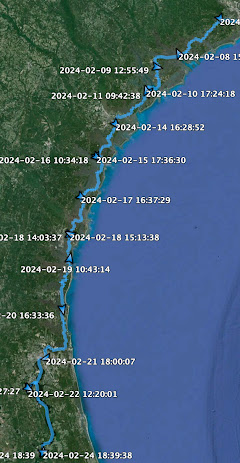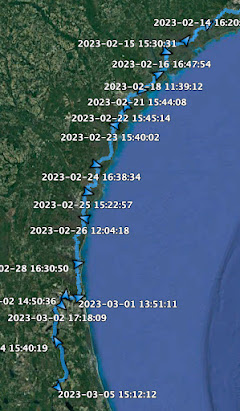Fourteen degrees is the forecast low for this coming Sunday. Too cold too early. I have a couple days off and hoped to sail. Best chance will be Monday when it should get up to 45 degrees with light wind out of the southwest. We'll see. The photograph below is for warmer times, a July sail a couple of years ago on the Pasquotank River.
This time of year is always a good time to think about maintenance. I've got three areas I need to work on: hull, sails and trailer.
The main effort on the hull will be adding bottom paint. I made some waterline marks on the fall sail plus Kevin B of Slip Jig fame has offered to loan me a laser level to strike the line. The hull will need touch up paint as always, but the bunk flat and cockpit sole that will require some epoxy work. Lots of wear and tear on those grey decks the last couple of years. I won't know until I sail again if I have fixed the leaked at the cb trunk. I hope I have stopped the trickle, if not I will have to disassemble and repair.
Sails need some cleaning. I have read that using water, a little vinegar and woolite is one way to go. I experimented with this with my sailing duffle bag which is made out of sail material and it did clean the duffle but did not remove the tiny specks of mildew, which I see on both the duffle and the sails. I have come across
another way to deal with mildew which I will paste below. I'm open to advice from anyone who has experience in this area. There is not much in the way of mildew on the sails, just tiny specks. But figure I should deal with it now.
-----------------------------------------------
1. Fill a tub or tank with water. It should be large enough that the sail you intend to wash can be fully immersed.
2. Add Clorox or other chlorine bleach to the water, in a ratio of approximately 30 to one. 'Clorox' is sodium hypochlorite in a 5.25% solution, so the resultant wash solution is slightly weaker than 0.2% (two parts per 1000) of sodium hypochlorite in water. The exact solution does not matter, however. We suspect that one part per 1000 is adequate, and we know that five parts per 1000 (10 to one Clorox in water) will not cause any damage.
3. Place the sail in the bath for at least 48 hours (and cover the tank since the chlorine likes to evaporate). Longer is probably better, for stubborn and very serious cases. Make sure the sail is fully submerged. Stack rocks or bricks on it if necessary, to keep it from floating. Force out as many air pockets as possible and make sure the sail is fully wet out. You might want to stir it every now and then, or shift it around.
4. Take the sail out of the sodium hypochlorite solution and check it. If it is not sufficiently clean, put it back in the bath for another day. When done, rinse it thoroughly with fresh water. Hang it to dry.
At the end of this, the sail should be almost completely clean and any remaining mildew will be absolutely dead, so lingering stains should fade fairly quickly when the sail is used. Exceptions will likely be under corner patches, under insignia cloth, and maybe inside a seam, though these spots should be greatly improved. More time in the solution will improve them.
---------------------------------------------
The broken axle was a wake-up call to keep up with trailer maintenance. I've got some U-bolts that need to be replace, plus a couple of brackets. My friends Michael and Sheila from Kantala showed me how to use lanolin on the threats of all bolts exposed to salt water, which I will do with all replacement pieces. Plus I have begun using a gel WD-40 to minimize future corrosion.
The maintenance won't be too difficult to accomplish. I will try to spread it out over the late winter early spring months with some sailing mixed in between. Wouldn't it be nice to have it all done before the spring sail in May?


























